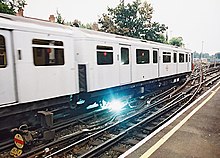Arcing fault

In electrical power engineering, an arc fault or arc fault is a technically undesirable arc between electrical system parts.
Voltage flashover

If there is insufficient distance or insufficient insulation between two electrical potentials , an undesired voltage flashover can occur, in the course of which an electric arc occurs. This voltage flashover can also occur in an electrical component itself because the contacts separate too slowly or the insulation layer between the live parts has been robbed of its insulating capacity.
The arcs that occur in the event of voltage flashover generally reduce the service life of the component massively and, in the worst case, can even destroy it.
Arcs are a considerable danger with non-insulated, bare high-voltage lines , as they can arise when the conductors involved are approached without contact, i.e. without direct contact. The high arc power and high arc temperature result in a strong lighting effect with a loud bang and combustible objects in the immediate vicinity can catch fire. Especially on high-voltage overhead lines of railway systems such as those of the Deutsche Bahn or ÖBB , serious electrical accidents occur again and again when people or other living beings approach below the required minimum distance (e.g. by climbing on a train roof) and an arc fault occurs .
In the low-voltage range, arcing faults can occur as a result of faults in electrical lines, usually with the following line damage:
- Damaged insulation as a result of line squeezing, damage from nails or screws or insufficient bending radii in electrical lines. Leakage currents can arise here due to dirt and deposits that ignite in an arc fault
- Loose contacts with incorrectly assembled components, rodent bites and erosion or kinked cables. This is where arcing faults occur due to ionized gases between the loose cable ends
On circuit boards , particularly often in switched-mode power supplies , flashovers cause considerable damage because the conductor material (copper) deposits on the circuit board material as a metal vapor layer and bridges creepage distances . If it is not possible to replace the entire assembly, such damage can be repaired through slots in the circuit board; the new creepage distance consists of an air gap. As a precautionary measure, soldering eyes with hollow rivets, thicker copper layers, conductor tracks reinforced with wire, chambered housings and generously dimensioned creepage distances are used. This is countered by miniaturization.
Osh
Due to the low loop impedances in the range of a few 10 mΩ in electrical power supply networks, such as the main distribution of low-voltage networks , short circuits or installation errors can lead to very high short-circuit currents of up to a few 10 kA. The resulting arc leads, due to the high instantaneous power, to sudden evaporation of metallic contact material, which can lead to thermal damage such as burns in the surrounding area.
For this reason, when working in the potential area of impact of an electric arc, appropriate fireproof protective clothing with face protection and visor must be worn and appropriate tools must be used. The danger areas include, among other things, the exchange of LV HRC fuse links when live in main distribution boxes or non-electrical maintenance work in switchgear operated with high voltage .
Plant protection
In the low voltage range, arcing faults can lead to fire damage. Various safeguards prevent such damage:
- Correctly designed circuit breaker , English Circuit-breaker or fuse can short-circuit currents selectively switch off and prevent further damage to the system.
- Arc fault protection devices English Arc-Fault Detection Devices , shortly AFDD can detect arcing faults in low voltage range and interrupt the flow of current. The designation fire protection switch can also be found in stores.
Another method for detecting arcing faults are detectors for UV radiation. Their use requires the system to be shielded from daylight. UV detectors are mainly used in power electronic circuits, in particular transmission devices.
literature
- Adolf J Schwab: electrical energy systems . 2nd updated edition. Springer, Berlin et al. 2009, ISBN 978-3-540-92226-1 .
Individual evidence
- ↑ Hans Kemper: dangers d. Insert. - Electricity (fire brigade expertise) . ecomed-Storck GmbH, 2015, ISBN 978-3-609-69792-5 ( limited preview in the Google book search [accessed on August 6, 2016]).
- ↑ Kögler / Cimolino: Standard rules of use: Electric current in use . ecomed-Storck GmbH, 2014, ISBN 978-3-609-69719-2 ( limited preview in Google Book Search [accessed December 8, 2016]).
- ↑ Michael Buchfelder, Albert Buchfelder: Handbuch der Erste Hilfe . Schattauer Verlag, 2006, ISBN 978-3-7945-2404-4 ( limited preview in Google Book Search [accessed December 8, 2016]).
- ↑ Arc fault protection Active and passive arc fault protection ( Memento of the original from April 28, 2010 in the Internet Archive ) Info: The archive link was inserted automatically and has not yet been checked. Please check the original and archive link according to the instructions and then remove this notice. , accessed on January 15, 2011
- ↑ DIN IEC 62606 draft standard
- ↑ Product example in specialist shops ( Memento of the original from August 20, 2012 in the Internet Archive ) Info: The archive link was inserted automatically and has not yet been checked. Please check the original and archive link according to the instructions and then remove this notice. , accessed on May 24, 2012

